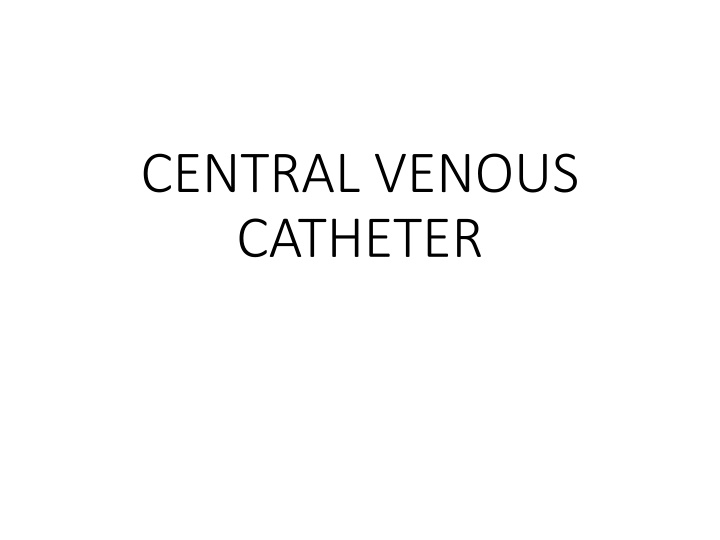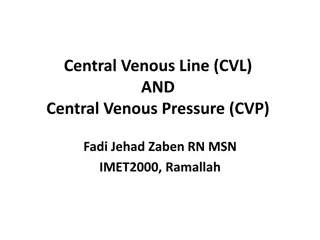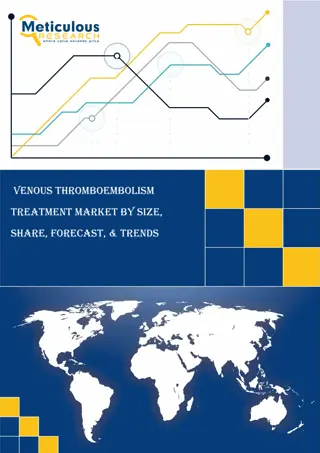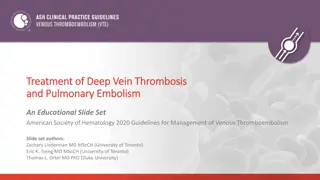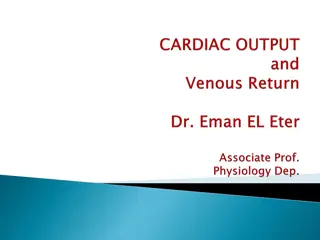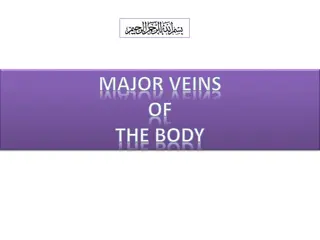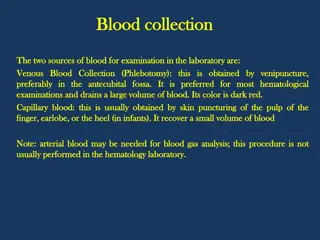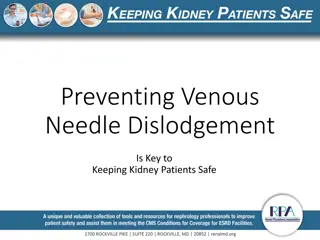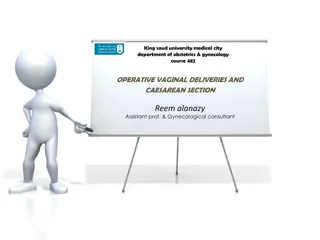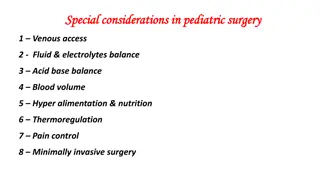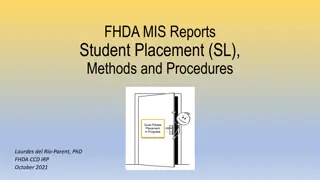Central Venous Catheters: Uses, Placement, and Indications
A central venous catheter (CVC) is a crucial medical device placed into a large vein for various purposes like administering medication, fluids, and obtaining blood tests. The catheter can be tunneled or non-tunneled, and specific sites are preferred for each type. Indications for CVC usage include long-term intravenous treatments, chemotherapy, and monitoring central venous pressure. However, there are contraindications such as local infections and low platelet counts that need to be considered.
Download Presentation

Please find below an Image/Link to download the presentation.
The content on the website is provided AS IS for your information and personal use only. It may not be sold, licensed, or shared on other websites without obtaining consent from the author.If you encounter any issues during the download, it is possible that the publisher has removed the file from their server.
You are allowed to download the files provided on this website for personal or commercial use, subject to the condition that they are used lawfully. All files are the property of their respective owners.
The content on the website is provided AS IS for your information and personal use only. It may not be sold, licensed, or shared on other websites without obtaining consent from the author.
E N D
Presentation Transcript
CENTRAL VENOUS CATHETER
Definition A central venous catheter (cvc) also known as a central line or central venous access catheter is a catheter placed into a large vein Regular sites : Catheters can be placed in veins , Neck ( internal jugular vein ), Chest ( subcalvin vein or axillary vein), Groin ( femoral vein), Peripherally inserted central catheters (picc)
Medical uses Adminster medication Fluids that are unable to be taken by mouth Would harm a smaller peripheral lines Obtain bloodtests
Indications Long term intravenous antibiotics ,parenteral nutrition in chronically ill persons Long term pain medications & chemotheraphy Drugs that are prone to cause phlebitis in peripheral veins such as : calcium chloride Chemotherapy Hypertonic saline Potassium chloride (kcl) Frequent blood draws Monitoring of the central venous pressure (cvp)
Tunnled catheters Preferable sites : Neck ( internal jugular Groin ( femoral ) Liver ( transhepatic ) Back ( translumbar ) The catheter is tunnled under the skin
Non tunneled - Catheters Preferable sites : First choice : right internal jugular vein Second choice : femoral vein Third choice : left internal jugular vein Last choice : subclavin vein with prefernce for the dominant side
Indications : Increasing age of patients intiating hemodialysis Increasing number of comorbid conditions including significant vascular disease Urgent renal replacement therapy (RRT)
Contraindications for tunneled and non -tunneled catheter Local cellulitis Low platelet Counts Local infection Avoid in raised intracranial Pressure Aim for a femoral approach if required Patient non -compliance
Complications Bleeding Infection Puncture of adjacent structures (such as other veins or arteries) Air embolism (air in the veins) Collapse of the lung (pneumothorax) Bleeding into the chest (hemothorax) Catheter breakage (when it is being removed)
Equipments: Sterile trolley(cvp tray) Sterile field, gloves, gown and mask Central line kit Saline flush Chlorhexidine .Lignocaine (4ml (2 vials) of 2% is reasonable) Suture Scalpel Central line fix
Pre procedure Consent patient if conscious otherwise document why the procedure is in the patient's best interests. Consent should include. Infection, bleeding (arterial puncture, haematoma, haemothorax), pain, failure, Set up sterile trolley. Position patient with head down if they can tolerate it, with head facing away from side of insertion This ensures maximum venous filling Having a nurse or assistant is helpful.
Procedure: Wash hands and wear sterile gown and gloves Clean the area and apply sterile field. Make sure to have some spare gauze swabs ready. Apply sterile sheath to the ultrasound probe Under ultrasound guidance insert lignocaine cutaneous, subcutaneously and around preferred site. Whilst lignocaine has time to work flush all lumens of the line and then clamp all lumens except the Seldinger port Ensure caps are available for the lumens Under ultrasound guidance take Seldinger needle attached to syringe and insert into the internal jugular vein When blood is freely aspirated remove syringe and immediately inset Seldinger wire. This should pass easily Keeping hold of the inserted wire, remove the needle. Ensure the wire stays in the vein as you do this.
Use scalpel to make an small incision in the skin (approx 3mm). This should be done cutting away from the wire so as not to damage it . Pass the dilator over the wire and gently but firmly dilate a tract through to the internal jugular. At this stage there may be some bleeding so ensure to have some swabs ready Remove the dilator and pass the central line over the Seldinger wire. Do not advance the line until you have hold of the end of the wire Once the central line is in place, remove the wire Aspirate and flush all lumens and re clamp and apply lumen caps Suture the line. Dress with a clear dressing so the insertion point can be clearly seen
Documentation: Patient is educated about the need Site assessed and marked All lumens clamped Inserted by Physician. Tip position confirmation via fluoroscopy OR chest X-ray Date and time of insertion, assess the site for extra bleeding. Anatomical location.
Cvp monitoring: Central venous pressure (CVP) is the blood pressure in the venae cavae, near the right atrium of the heart. CVP reflects the amount of blood returning to the Heart and the ability of the heart to pump the blood back into the arterial system. The normal range for CVP is 0 to 5 mm H2O
Care of cvp line: Site Care: - Skin Disinfectant - Clean, dry, and occlusive dressings. PROCEDURE FOR SITE CARE AND DRESSING CHANGE 1. Remove dressing from VAD insertion site. 2. Inspect Site and catheter 3. Disinfect the catheter-skin junction using antiseptic solution 4. Dress access site
AFTER PROCEDURE: 1. Discard used supplies 2. Remove gloves 3. Wash hands 4. Label new dressing 5. Document
